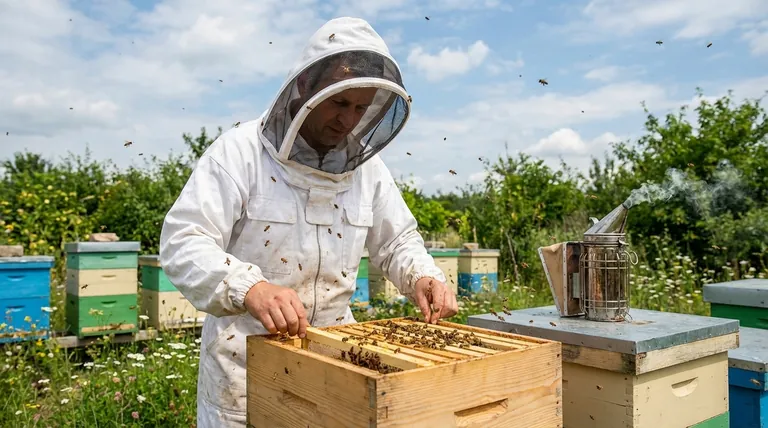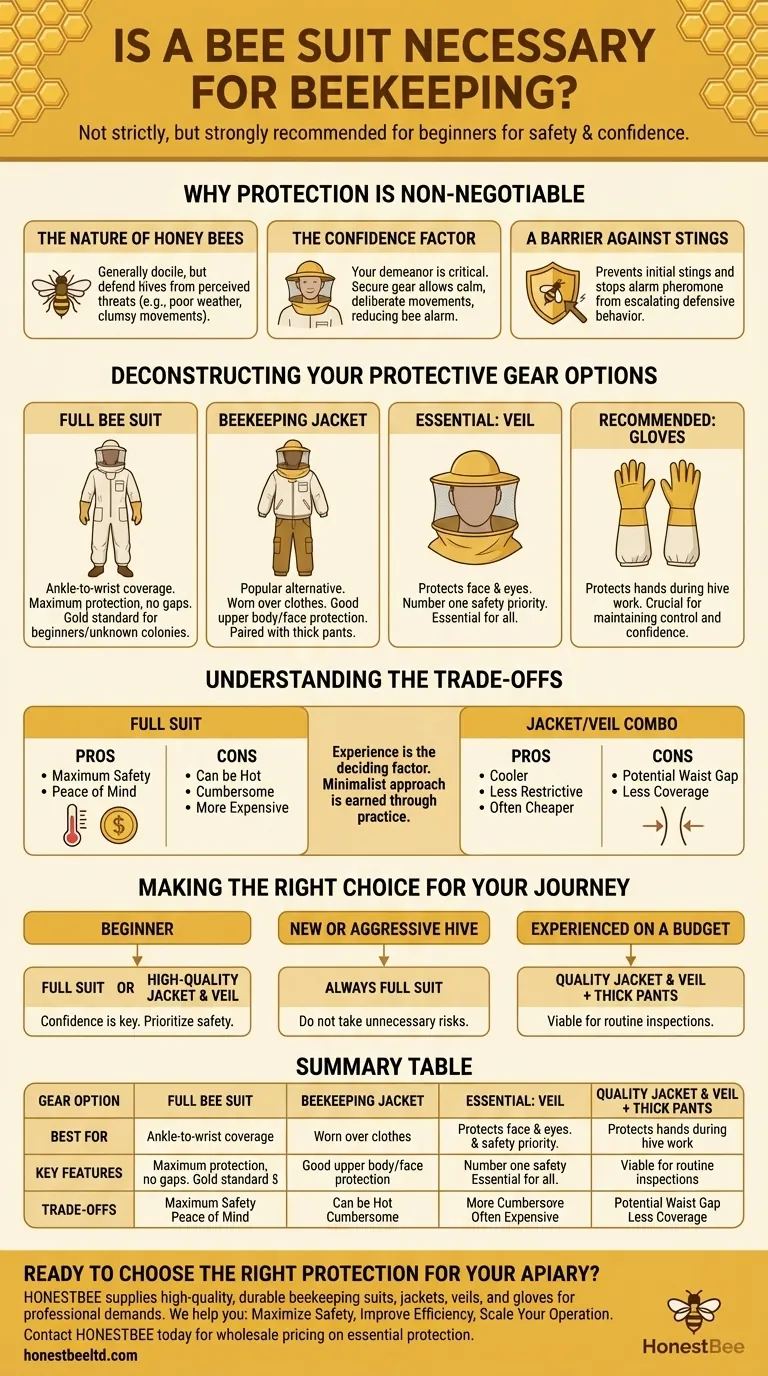Strictly speaking, no, a full bee suit is not an absolute necessity for beekeeping. Many experienced beekeepers opt for a simpler jacket-and-veil combination paired with durable pants. However, for a beginner, a full suit is the most highly recommended option because the confidence it provides is as critical as the physical protection it offers.
The decision to wear a full suit is not a simple yes-or-no question. It's a calculated assessment of risk based on your experience level, the specific task you are performing, and the temperament of your bees. For beginners, maximizing protection is the wisest path to building confidence and competence.

Why Protection is Non-Negotiable
While a full suit is optional, having adequate protective gear is not. Understanding the reasons behind this is the first step to making an informed decision about your equipment.
The Nature of Honey Bees
Honey bees are generally docile and focused on their work. They do not seek to sting.
However, they are wild animals that will defend their colony if they perceive a threat. Factors like poor weather, the time of year, or a beekeeper's clumsy movements can quickly shift a hive's mood from calm to defensive.
The Confidence Factor
Your demeanor is a critical beekeeping tool. Bees are sensitive to jerky, panicked movements.
Feeling secure in your protective gear allows you to move with calm, deliberate confidence. This calm state is less likely to alarm the bees, creating a positive feedback loop that makes inspections safer and more pleasant for both you and the hive.
A Barrier Against Stings
A bee sting releases an alarm pheromone that signals a threat to other bees, potentially inciting a chain reaction of more stings.
Protective gear serves as a physical barrier that not only prevents the initial sting but also stops this chemical signal from escalating the situation.
Deconstructing Your Protective Gear Options
The term "protective gear" covers a range of items. The choice is not simply "suit or no suit," but rather which combination of components is right for you.
The Full Bee Suit
This is a single garment that covers you from your ankles to your wrists, typically with a veil built into the hood.
It offers the most complete protection, leaving virtually no gaps for bees to enter. This is the gold standard for beginners and for anyone working with an unknown or aggressive colony.
The Beekeeping Jacket
This is the most popular alternative to a full suit. It is a jacket, often ventilated, that includes an integrated hood and veil.
Beekeepers wear this over their regular clothes, paired with thick, light-colored pants like jeans. It offers excellent protection for the upper body and face, which are the most common targets for stings.
Essential Components: Veil and Gloves
Regardless of your choice for body covering, a veil is essential. Protecting your face, and especially your eyes, is the number one safety priority.
Gloves are also highly recommended, particularly for beginners. Your hands perform the most invasive actions within the hive, and protecting them is crucial for maintaining control and confidence.
Understanding the Trade-offs
Every equipment choice involves a balance of competing factors. Being aware of these trade-offs is the mark of a thoughtful beekeeper.
Full Suit: Maximum Safety vs. Comfort
A full suit provides unparalleled peace of mind. Its primary downside is comfort and cost. In hot weather, a full suit can become extremely warm, and it is more cumbersome to put on and take off than a simple jacket.
Jacket/Veil Combo: Flexibility vs. Gaps
A jacket is cooler, less restrictive, and often less expensive. The trade-off is the potential for a gap at your waist between the jacket and your pants. While this risk can be minimized, it is a point of vulnerability that a full suit eliminates.
Experience as the Deciding Factor
Experienced beekeepers often use less protection because they have developed the skill to "read" a hive's mood and move in a way that minimizes disturbance.
This minimalist approach is a privilege earned through hundreds of hours of practice. For a beginner, trying to emulate this can lead to a negative and painful experience that damages confidence.
Making the Right Choice for Your Journey
Your protective gear should match your experience level and your beekeeping goals. Use the following guidelines to make a decision.
- If you are a beginner: Start with a full suit or, at minimum, a high-quality ventilated jacket and veil. The confidence it gives you is just as important as the physical protection.
- If you are working with a new or aggressive hive: Always use a full suit. Do not take unnecessary risks until you are certain of the colony's temperament.
- If you are an experienced beekeeper on a budget: A quality jacket and veil paired with thick, light-colored pants is a perfectly viable and effective setup for most routine inspections.
Ultimately, your protective gear is a tool that enables you to be a calm, confident, and effective caretaker for your bees.
Summary Table:
| Gear Option | Best For | Key Features | Trade-offs |
|---|---|---|---|
| Full Bee Suit | Beginners, aggressive hives | Maximum protection, full body coverage, built-in veil | Can be hot, more expensive, less flexible |
| Beekeeping Jacket & Veil | Experienced beekeepers, routine inspections | Ventilated, more comfortable, easier to put on | Potential gap at waist, less coverage than a full suit |
| Veil (Essential) | All beekeepers | Protects face and eyes from stings | Must be paired with other protective clothing |
| Gloves (Recommended) | Beginners, all beekeepers | Protects hands during invasive hive work | Can reduce dexterity for some tasks |
Ready to Choose the Right Protection for Your Apiary?
Whether you're a commercial apiary managing hundreds of hives or a distributor stocking up on reliable gear, having the right protective equipment is fundamental to safe and efficient operations. HONESTBEE supplies high-quality, durable beekeeping suits, jackets, veils, and gloves designed for the demands of professional beekeeping.
We help you:
- Maximize Safety: Protect your team with gear that builds confidence and minimizes stings.
- Improve Efficiency: Durable, well-designed equipment allows for calmer, more productive hive inspections.
- Scale Your Operation: Reliable wholesale supplies ensure your entire apiary or distributor network is properly equipped.
Let's discuss your specific needs. Contact HONESTBEE today for wholesale pricing on essential beekeeping protection.
Visual Guide

Related Products
- Cotton Beekeeping Suit and Round Hat with Veil Bee Keeper Protective Gear
- Beekeeping Jacket with Hood and Veil for Beekeepers
- White Beekeeping Protective Suit and Hat with Fencing Veil for Beekeepers
- Professional Beekeeping Suit for Kids and Girls Childrens Bee Keeper Suit
- Heavy Duty Cowboy Beekeeper Hat with Visibility Veil Outdoor Professional Beekeeping Protective Gear
People Also Ask
- What is recommended for beginners in beekeeping regarding protective clothing? A Complete Safety Guide for New Beekeepers
- What are the benefits of a fully ventilated beekeeping suit? Stay Cool and Protected in Hot Climates
- Do beekeeping suits completely prevent stings? Maximize Your Apiary Safety with the Right Gear
- How should a bee suit be cleaned? Protect Your Investment and Ensure Apiary Safety
- What are bee suits made of? Choosing the Right Material for Maximum Protection & Comfort



















